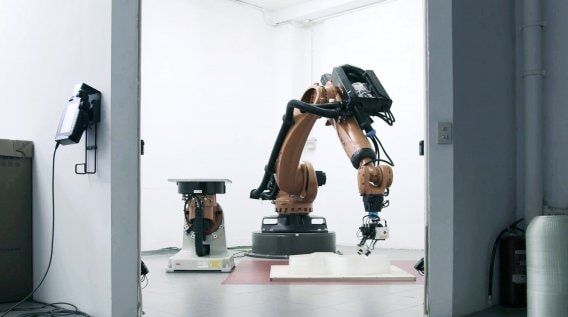Worldwide Sites
You have been detected as being from . Where applicable, you can see country-specific product information, offers, and pricing.
Keyboard ALT + g to toggle grid overlay
A small start-up is disrupting the marine manufacturing industry with MAMBO.
The sleek and seductive motor trimaran looks like an azure wave gliding across the water. Finished in high gloss aquamarine, 6.5 meters in length, with sharp twin bows and ultra-fluid lines, it turned many heads at the 2020 Genoa Boat Show. But could anyone tell, on first look, that this was MAMBO, the world’s first fully functional and navigable 3D-printed fiberglass boat?
A glimpse into the future of boat building
For decades, fiberglass boat hulls have been molded using a costly custom-made mold that may only be used once. The superstructure is then laid up manually with fiberglass and resin. Moi Composites, a spin-out from the Politecnico di Milano, has developed a process to 3D print a boat, eliminating the mold and leaving the printed sections to be joined with a final lay-up process.
Fiberglass boat builders face an age-old problem. Many specialist boats and yachts are one-offs or made in short production runs. This means that the mold created to make the hull is an expensive, one-off capital cost. Two engineering researchers at the Politecnico di Milano, Michele Tonizzo and Gabriele Natale, were already thinking outside the box, making new things using additive manufacturing; "what if we could print a boat?" they asked.
Cruise forward: “MAMBO”, a radical change in boat design and, possibly, a glimpse into the future of boat building.
Passionate co-creators Gabriele and Michele explain the limitations of molding boat hulls. A designer will typically design a beautiful boat, a concept that the owner loves, but the shipyard can’t make it precisely to that design, economically.
“It’s normal to design a boat and then think about how to make it,” says Michele. “When people design a mold, they often realize that the shape cannot be made practically; so you go back and repeat the process many times. When perfected you then have to make the mold, which is a high fixed cost.” Printing the boat removes this issue completely.
Team spirit
With a powerful Mercury outboard propelling 800kg displacement, MAMBO handles well in the water and clocked 26 knots on its first sea trial; a commendable speed for any motorboat. “It’s designed to be cool rather than fast, so this was good,” Michele says.
Part of the method to MAMBO’s success is teamwork. Moi Composites worked in collaboration with Autodesk, Catmarine, Micad, Owens Corning, and Mercury on the additive manufactured vessel. Each partner brought a specialist discipline: Micad for naval architecture, and Autodesk software to connect the entire process, from concept to sea-ready vessel and so on.
We designed it and split it into sections, in Fusion 360,” says Michele. “We brought it into NetFabb to see how to slice the section, and we used PowerMill to simulate the pathways for the different robots.”
(KUKA) Robots were used to build – or print – the boat. Using a special end effector developed by Moi, the robot injects fiberglass and resin in layers, using one robot at the Advanced Manufacturing Facility in Birmingham, UK, and another one at the Politecnico di Milano. After the sections were printed they were shipped to Puglia, Italy, where they were joined by lamination, using a traditional FRP lay-up process.
The hull itself was modeled on an original racing boat hull for the ArchDiavolo, a successful 1970s design by renowned naval architect Sonny Levi.
Apart from the strong team, MAMBO’s success comes freedom from constraints and the courage to use new technology. Moi Composites was born from a mindset of experimental freedom in design combined with engineering rigor. From outset, the team wanted no limits in the design but they also knew that single, custom boats have this big disadvantage: the costly mold – especially in a boat-obsessed country like Italy.
“Every year, designers realize amazing concepts for new yachts but, many times, when they enter production they need to rethink it,” says Michele. “It can be an extremely difficult shape to manufacture, so these beautiful concepts frequently remain 3D models, forever.”
The market: customized boats on demand
MAMBO is a demonstrator. It was shown at the Genoa Show and there are plans for a media demo day at Lake Como this summer. Can MAMBO’s novel manufacturing process find a commercial market?
In Italy, near Genoa especially, racing boats are part of the culture. Most competition racing boats are one-offs, where printing a boat without a mold would be far more economical and have fewer design constraints than traditional laying-up.
A second potential market for the 3D printing process could be luxury boats or “super-yachts; an ambitious owner could customize every single element of their vessels – customers often want a unique product. However, Michele says super-yacht builders are not actively interested in the idea yet; building larger vessels will require a scale-up of machines and the whole process.
Support gives agile start-ups the edge
Moi Composites, a small start-up, had the support of several big names in the engineering and marine industry.
“They really contributed all the way from concept to delivery, through the design, production, and assembly. It was great to be assisted and supported,” says Gabriele. The software, provided by Autodesk, was essential but so were the people who helped at each stage. People who are knowledgeable and passionate about their job made MAMBO happen. It will now be exhibited at trade shows, conferences, and media days, to generate awareness of the application of the unique digital workflow used to manufacture the boat (large-scale part).
“The idea was to create a one-of-a-kind design and process that says to others “we can do it”, challenging an age-old method using new technology,” says Gabriele.



